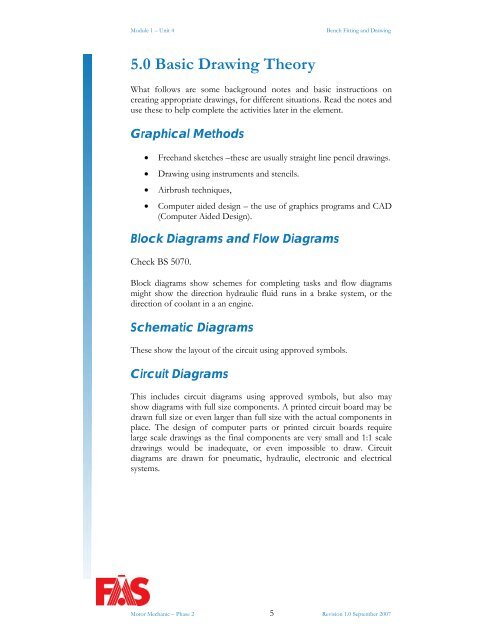TRADE OF HEAVY VEHICLE MECHANIC - eCollege
TRADE OF HEAVY VEHICLE MECHANIC - eCollege
TRADE OF HEAVY VEHICLE MECHANIC - eCollege
You also want an ePaper? Increase the reach of your titles
YUMPU automatically turns print PDFs into web optimized ePapers that Google loves.
Module 1 – Unit 4 Bench Fitting and Drawing<br />
5.0 Basic Drawing Theory<br />
What follows are some background notes and basic instructions on<br />
creating appropriate drawings, for different situations. Read the notes and<br />
use these to help complete the activities later in the element.<br />
Graphical Methods<br />
• Freehand sketches –these are usually straight line pencil drawings.<br />
• Drawing using instruments and stencils.<br />
• Airbrush techniques,<br />
• Computer aided design – the use of graphics programs and CAD<br />
(Computer Aided Design).<br />
Block Diagrams and Flow Diagrams<br />
Check BS 5070.<br />
Block diagrams show schemes for completing tasks and flow diagrams<br />
might show the direction hydraulic fluid runs in a brake system, or the<br />
direction of coolant in a an engine.<br />
Schematic Diagrams<br />
These show the layout of the circuit using approved symbols.<br />
Circuit Diagrams<br />
This includes circuit diagrams using approved symbols, but also may<br />
show diagrams with full size components. A printed circuit board may be<br />
drawn full size or even larger than full size with the actual components in<br />
place. The design of computer parts or printed circuit boards require<br />
large scale drawings as the final components are very small and 1:1 scale<br />
drawings would be inadequate, or even impossible to draw. Circuit<br />
diagrams are drawn for pneumatic, hydraulic, electronic and electrical<br />
systems.<br />
Motor Mechanic – Phase 2 5 Revision 1.0 September 2007
















